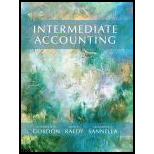
Intermediate Accounting
1st Edition
ISBN: 9780132162302
Author: Elizabeth A. Gordon, Jana S. Raedy, Alexander J. Sannella
Publisher: PEARSON
expand_more
expand_more
format_list_bulleted
Textbook Question
Chapter 7, Problem 7.14BE
Future Value of an Ordinary Annuity: Calculating Payments. Assume that you need to have $25,000 in four years. How much must you invest at the end of each year to reach your goal? You will earn 8% interest compounded annually Draw a timeline to illustrate the problem.
Expert Solution & Answer
Want to see the full answer?
Check out a sample textbook solution
Students have asked these similar questions
I am searching for the accurate solution to this general accounting problem with the right approach.
None
I need help solving this general accounting question with the proper methodology.
Chapter 7 Solutions
Intermediate Accounting
Ch. 7 - Prob. 7.1QCh. 7 - Prob. 7.2QCh. 7 - If interest is compounded more than once a year,...Ch. 7 - Prob. 7.4QCh. 7 - Can an ordinary annuity table be used to determine...Ch. 7 - Prob. 7.6QCh. 7 - Is the present value of an ordinary annuity more...Ch. 7 - Prob. 7.8QCh. 7 - Simple Interest. Assume Shafer Corporation...Ch. 7 - Compound Interest. Assume Shafer Corporation...
Ch. 7 - Prob. 7.3BECh. 7 - Prob. 7.4BECh. 7 - Prob. 7.5BECh. 7 - Present Value of a Single Sum, Compound Interest....Ch. 7 - Future Value of a Single Sum, Compound Interest....Ch. 7 - Prob. 7.8BECh. 7 - Present Value of a Single Sum, Compounded Interest...Ch. 7 - Prob. 7.10BECh. 7 - Present Value of a Single Sum, Calculating Time...Ch. 7 - Future Value of an Ordinary Annuity. An...Ch. 7 - Future Value of an Annuity Due. Mariah Carey...Ch. 7 - Future Value of an Ordinary Annuity: Calculating...Ch. 7 - Present Value of an Ordinary Annuity. CB...Ch. 7 - Present Value of an Annuity Due, Semiannual...Ch. 7 - Prob. 7.17BECh. 7 - Ordinary Annuity, Annuity Due, Using Interest...Ch. 7 - Prob. 7.2ECh. 7 - Prob. 7.3ECh. 7 - Prob. 7.4ECh. 7 - Prob. 7.5ECh. 7 - Prob. 7.6ECh. 7 - Prob. 7.7ECh. 7 - Future Value of an Ordinary Annuity, Future Value...Ch. 7 - Single Sum, Solving for Other Variables. Two...Ch. 7 - Ordinary Annuity, Solve for Interest Rate,...Ch. 7 - Present Value, Note Payable Prices. Wiz Khalifa...Ch. 7 - Future Value of a Deterred Annuity. Lenny Shafer...Ch. 7 - Prob. 7.13ECh. 7 - Present Value of an Ordinary Annuity, Present...Ch. 7 - Prob. 7.15ECh. 7 - Prob. 7.16ECh. 7 - Future Value of an Annuity Due, Decision Making....Ch. 7 - Prob. 7.18ECh. 7 - Prob. 7.19ECh. 7 - Prob. 7.20ECh. 7 - Prob. 7.21ECh. 7 - Prob. 7.22ECh. 7 - Prob. 7.1PCh. 7 - Present Value, Present Value of an Ordinary...Ch. 7 - Present Value, Present Value of an Annuity Due,...Ch. 7 - Prob. 7.4PCh. 7 - Prob. 7.5PCh. 7 - Prob. 7.6PCh. 7 - Prob. 7.7PCh. 7 - Present Value of an Annuity Due, Deferred...Ch. 7 - Present Value of an Ordinary Annuity, Present...Ch. 7 - Future Value of an Ordinary Annuity, Deferred...Ch. 7 - Present Value, Present Value of an Ordinary...Ch. 7 - Prob. 7.12PCh. 7 - Prob. 7.13PCh. 7 - Expected Cash Flows. Hiteck Electronics sells a...Ch. 7 - Prob. 7.15P
Knowledge Booster
Learn more about
Need a deep-dive on the concept behind this application? Look no further. Learn more about this topic, accounting and related others by exploring similar questions and additional content below.Similar questions
- I need help with this general accounting question using the proper accounting approach.arrow_forwardPlease provide the correct answer to this general accounting problem using valid calculations.arrow_forwardCan you explain the correct methodology to solve this general accounting problem?arrow_forward
- Can you solve this general accounting question with the appropriate accounting analysis techniques?arrow_forwardCan you solve this general accounting problem using appropriate accounting principles?arrow_forwardPlease help me solve this general accounting question using the right accounting principles.arrow_forward
- Please provide the answer to this general accounting question with proper steps.arrow_forwardI am trying to find the accurate solution to this general accounting problem with the correct explanation.arrow_forwardPlease provide the answer to this general accounting question with proper steps.arrow_forward
arrow_back_ios
SEE MORE QUESTIONS
arrow_forward_ios
Recommended textbooks for you
- Principles of Accounting Volume 2AccountingISBN:9781947172609Author:OpenStaxPublisher:OpenStax College
 Pfin (with Mindtap, 1 Term Printed Access Card) (...FinanceISBN:9780357033609Author:Randall Billingsley, Lawrence J. Gitman, Michael D. JoehnkPublisher:Cengage Learning
Pfin (with Mindtap, 1 Term Printed Access Card) (...FinanceISBN:9780357033609Author:Randall Billingsley, Lawrence J. Gitman, Michael D. JoehnkPublisher:Cengage Learning

Principles of Accounting Volume 2
Accounting
ISBN:9781947172609
Author:OpenStax
Publisher:OpenStax College

Pfin (with Mindtap, 1 Term Printed Access Card) (...
Finance
ISBN:9780357033609
Author:Randall Billingsley, Lawrence J. Gitman, Michael D. Joehnk
Publisher:Cengage Learning
What Does ROI (Return On Investment) Really Mean?; Author: REtipster;https://www.youtube.com/watch?v=Z6ThJvNr1Dw;License: Standard Youtube License